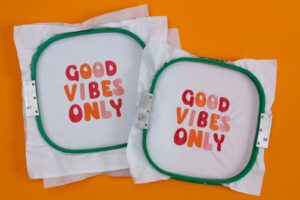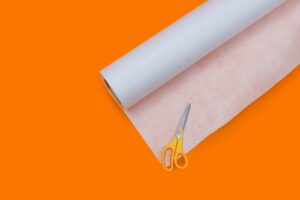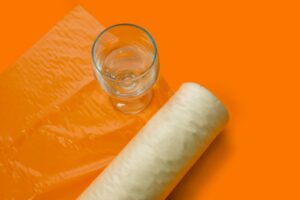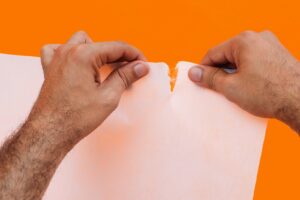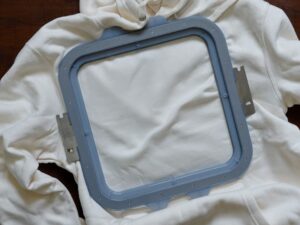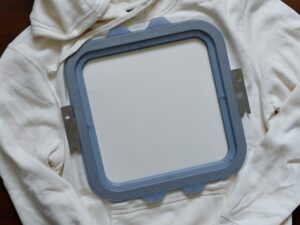If you know anything about machine embroidery, you’ve probably heard the term ‘backing’ or ‘stabilizer’. In the world of embroidery the terms stabilizer and backing are used interchangeably and for this post we will be using the word stabilizer just to make things consistent.
What Is Embroidery Stabilizer?
Stabilizer is a sheet of material that is hooped and embroidered along with the fabric you are embroidering. It supports the fabric and stitches during the embroidery process and after being laundered . Choosing the right embroidery stabilizer is crucial for a high quality finished product.
Stabilizers are recommended for almost every fabric, with a few exceptions.
Figure 1: Embroidery with and without stabilizers
Quality Of Stabilizers
It’s important to use stabilizers designed specifically for machine embroidery. Using unconventional materials like coffee filters, newspaper, or paper towels as stabilizers can lead to issues. As a general rule of thumb, if you look at a stabilizer and see lighter areas and darker areas, it means the stabilizer is not homogeneous and you will not get a consistent stitch.
Categories Of Stabilizers
Stabilizers can be classified into woven and non woven:
Non Woven Stabilizers:
Are made of two different processes; chemical bonded non woven and wet laid non woven.
Chemical bonded non woven stabilizers are basically rayon or polyester fibers bonded together, using chemical binders.
Wet laid stabilizers are made out of a sludge of fiber and solute. Which is laid on a screen and then dried. Once dried, it produces a multidirectional and uniform non woven stabilizer.
Woven Stabilizers:
Have a tight weave, they move and feel like a fabric. Which makes them great for performance wear and stretchy fabrics where it can be challenging to achieve smooth, crisp embroidery designs. Woven stabilizers are also suited for moisture wicking performance wear products, polos, infant and children apparel.
Main Types Of Stabilizers
Various types of stabilizers exist, such as cutaway, tearaway, fusible, heataways and water-soluble, catering to different needs. Most embroiders have a go to stabilizer, that they use on a regular basis and are very comfortable with. After a bit of trail and error you can decide which stabilizers are best for your work process.


Figure 2: Cutaway Stabilizer [L], Water Stabilizer [M], Tear Away Stabilizer [R]
Further Variations Of Stabilizers:
Tear away, fusible, heataways and water soluble stabilizers are further categorized according to their weight and stiffness.
Stabilizer Weights:
Typically, stabilizers are available in different weights, ranging from 1 ounce to 3.5 ounces. These are the three categories of weight:
Light-weight: 1 to 1.5 ounces
Medium-weight: 2 to 2.75 ounces
Heavy-weight: 3 to 3.5 ounces
The higher the stitch count of the design or thicker the fabric, the heavier the stabilizer should be.
Factors To Consider While Choosing Stabilizers
Fabric Construction:
Stretchy or loose fabrics, such as knits, and lightweight, loosely Woven Fabrics, such as linens, dress shirts, require Cutaway stabilizers. On the other hand, Heavyweight, stable tightly woven fabrics need a tearaway stabilizer.
Stitch Count:
The higher the stitch count, the more support the fabric needs to stay put. Therefore, designs with high stitch count (above 6000 stitches) require a heavier stabilizer. With lighter and more open designs, we use a lighter stabilizer.
Layering And Future Use:
The number of stabilizer sheets depends on the fabric, design complexity, and number of stitches. It is recommended to start with one sheet and adjust based on trial samples.
Layering is suggested for higher stability, this prevents issues like lost registration, waviness, or thinning of designs on fabrics, hence enhancing the overall look and durability of the embroidered design.
Layering is especially useful for uniforms because they get used and washed a lot. This ensures designs remain flat and high-quality even after washing. However, keep in mind that Thicker doesn’t always mean better, greater stability may not be achieved with multiple layers of stabilizer. A single layer of a good stabilizer should be sufficient for most projects.
Proper Registration Depends On Stabilizer:
When fabric and stabilizer are hooped together, they should feel taut, like a tambourine. The right stabilizer reinforces and supports the fabric, preventing stretching during embroidery and reducing fabric pull. The non-directional makeup of a good stabilizer provides equal tension in all directions.
Stabilizers achieve drum like skin tension within the hoop, which helps in perfect registration of the design. Another factor that helps achieve perfect registration is the ratio between the bobbin thread and top thread
Creating a “tambourine skin” type tension within the hoop is key to proper registration.

Figure 3: Tambourine like tension
